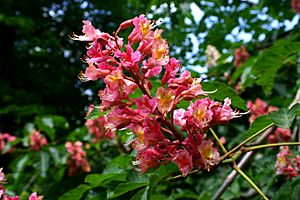Aesculus facts for kids
The Aesculus genus includes trees and shrubs commonly known as buckeye and horse chestnut. These plants are flowering trees that belong to the Sapindaceae family, also known as the soapberry family. You can find them growing naturally in the northern parts of the world, especially in North America and Eurasia. There are about 13 to 19 different types, or species, of Aesculus.
Even though they share names, buckeye and horse chestnut trees are not related to true chestnut trees, which are in a different plant group called Castanea. Sometimes, people call these trees "conker trees" in Britain because their seeds, called "conkers," are used to play a game called conkers.
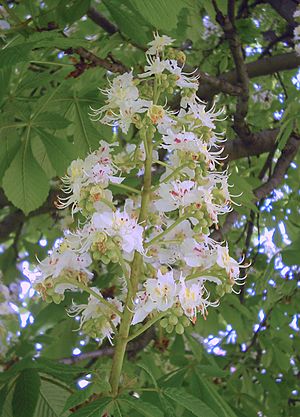
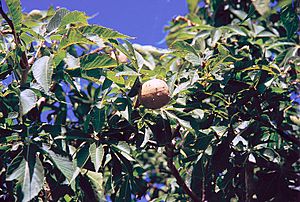
The famous scientist Carl Linnaeus gave the genus the name Aesculus. He named it after an old Roman word for an edible acorn.
Contents
What They Look Like
Aesculus trees have strong branches with sticky buds that often have a special resin on them. Their leaves are very large and spread out like a hand, with several leaflets coming from one point. For example, the Japanese horse chestnut (A. turbinata) can have leaves up to 65 centimeters (about 25 inches) wide! Some species lose their leaves in the fall (deciduous), while others keep them all year (evergreen).
The flowers are very colorful and attract insects or birds. They have four or five petals that are joined together, forming a tube shape. These flowers grow in large clusters called panicles.
After the flowers, the tree produces a round fruit, usually 2 to 5 centimeters (about 1 to 2 inches) wide. This fruit is a capsule, and it usually holds one to three seeds inside. People often mistakenly call these seeds "nuts." If there's more than one seed in a capsule, the seeds might be flat on one side. The spot where the seed was attached inside the capsule leaves a large, round, white scar. Some fruits have "spines" (like small prickles), while others are bumpy or smooth. When the fruit is ripe, it splits into three parts to release the seeds.
Important Facts About Aesculus
For thousands of years, until about 300 AD, the Jōmon people in Japan would eat Aesculus seeds. However, they had to prepare them carefully by boiling them many times to remove harmful substances, a process called leaching.
It's important to know that all parts of the buckeye or horse chestnut tree are a bit poisonous, including the seeds. If eaten, they can upset your stomach. This is because they contain natural chemicals like saponin aescin and glucoside aesculin.
Native Americans had a clever use for the seeds. They would crush them and throw the mashed seeds into calm or slow-moving water. This would make fish dizzy or sleepy, making them easier to catch. They would then boil and drain the fish at least three times to make sure the fish were safe to eat. Even new shoots growing from the seeds can be harmful to animals like cattle if they eat them.
Scientists used to think these trees belonged to their own special plant family. But after studying them closely, they found that Aesculus trees actually belong to the soapberry family, which also includes maple trees.
Types of Aesculus Species
Here are some of the different types of Aesculus trees:
| Image | Scientific name | Common name | Where it grows |
|---|---|---|---|
 |
Aesculus assamica | From northeast India to southern China and northern Vietnam | |
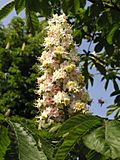 |
Aesculus hippocastanum | horse chestnut | Europe (native to the Balkans); also found in northeastern North America |
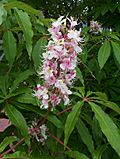 |
Aesculus indica | Indian horse chestnut | Eastern Asia |
 |
Aesculus chinensis | Chinese horse chestnut | Eastern Asia |
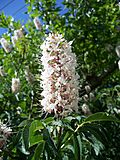 |
Aesculus californica | California buckeye | Western North America |
 |
Aesculus flava (A. octandra) | yellow buckeye | Eastern North America |
 |
Aesculus glabra | Ohio buckeye | Eastern North America |
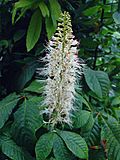 |
Aesculus parviflora | bottlebrush buckeye | Eastern North America |
 |
Aesculus parryi | Parry's buckeye | Western North America, only found in Baja California del Norte |
 |
Aesculus pavia | red buckeye | Eastern North America |
 |
Aesculus sylvatica | painted buckeye | Eastern North America |
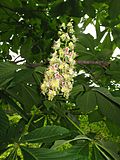 |
Aesculus turbinata | Japanese horse chestnut | Japan |
 |
Aesculus wangii | horse chestnut | Eastern Asia |
Growing Aesculus Trees
The most well-known Aesculus tree around the world is the common horse chestnut, Aesculus hippocastanum. The yellow buckeye, Aesculus flava, is also a popular tree to plant because of its pretty yellow flowers.
If you're looking for a smaller plant, the bottlebrush buckeye, Aesculus parviflora, is a beautiful flowering shrub. People also grow other types of Aesculus as ornamental plants in gardens and parks. There are even special hybrid trees, like the red horse chestnut (Aesculus × carnea), which is a mix of A. hippocastanum and A. pavia.
Aesculus in Art and History

You can see designs inspired by horse chestnut leaves in the detailed carvings on columns at the Reims Cathedral in France.
The horse chestnut tree wasn't originally from Britain. It was brought there from Europe in 1650.
The leaf of the Aesculus tree was an important symbol for the city of Kyiv, the capital of Ukraine. It was on their coat of arms from 1969 to 1995 and is still an official symbol of the city today.
During the 1840 U.S. presidential campaign, candidate William Henry Harrison called himself the "log cabin and hard cider candidate." He wanted to show he was a simple man, so he pretended to sit in a log cabin made of buckeye logs. This is why Ohio became known as "the Buckeye State."
In Geneva, Switzerland, there's an official chestnut tree that helps mark the start of spring. Every year since 1818, the secretary of Geneva's local parliament watches this tree. When the first leaf opens, it's recorded and announced to the public! Over the years, four different horse chestnut trees have been used for this special tradition.
See also
 In Spanish: Aesculus para niños
In Spanish: Aesculus para niños
- Anne Frank tree


